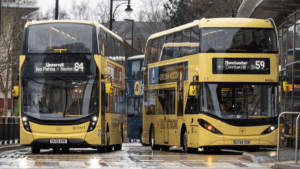Electric flying cars might seem like the stuff of science fiction, but a new study claims they could be a realistic solution to congestion and poor air quality.
Known formally as electric vertical takeoffs, or VTOLs, the University of Michigan study looked at the energy use, emissions and time savings of VTOLs compared to passenger cars.
Researchers analysed energy use and emissions during five phases of VTOL flight, from take off to landing, and found that the aircraft use a lot of energy during takeoff and climb but are relatively efficient during cruise phase, travelling at 150 mph.
The researchers found that for trips of 100 kilometres (62 miles), a fully loaded VTOL carrying a pilot and three passengers had lower greenhouse gas emissions than ground-based cars with an average vehicle occupancy of 1.54.
Emissions from the VTOL were 52% lower than petrol vehicles and 6% lower than battery-electric vehicles.
Dave Brenner/University of Michigan School for Environment and SustainabilityBut for shorter trips, passenger cars were still more efficient due to the amount of energy used during take off.
The study, published today (April 9) in Nature Communications, argues that VTOLs could play a niche role in sustainable mobility for longer trips and several companies around the world are developing VTOL prototypes.
However, they noted that many other questions need to be addressed to assess the viability of VTOLs, including cost, noise and societal and consumer acceptance.
Akshat Kasliwal, first author of the study and a graduate student at the University of Michigan’s School for Environment and Sustainability, said the findings can help guide the sustainable deployment of the emerging technology.
‘With these VTOLs, there is an opportunity to mutually align the sustainability and business cases,’ Kasliwal said. ‘Not only is high passenger occupancy better for emissions, it also favors the economics of flying cars. Further, consumers could be incentivized to share trips, given the significant time savings from flying versus driving.’
















